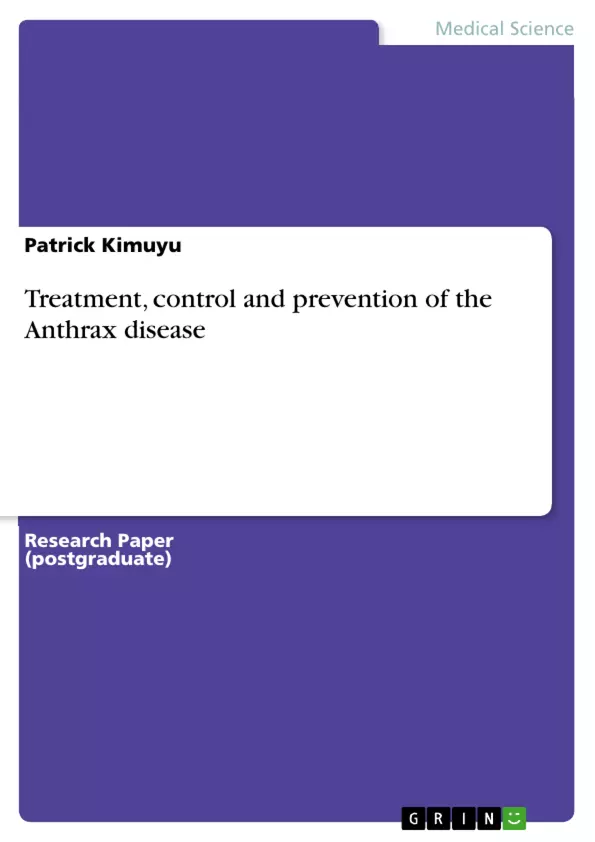Anthrax is a bacteria-caused disease that affects mammals of the bovine and caprine species, and it causes fatal deaths in humans. The most affected domestic animals include goats, sheep, cattle and horses. It is a fatal disease in animals owing to the fact that, it is transmitted from one herbivorous animal to another the same way as other zoonotic diseases. Anthrax toxins cause fatal effects on the central nervous system, the brain and heart. It is believed that the symptoms and signs presented in anthrax infection are as a result of the toxic effects on some vital organs and systems.
The treatment of anthrax depends on the form of anthrax involved although therapeutic agents target the disease causing pathogen, Bacillus anthracis. As such, antibiotics are used to destroy the anthrax causing bacteria. Some of the most potent antibiotics include penicillin, ciprofloxacin and doxycycline.
Despite the fatality associated with anthrax, reliable preventive and control measures reduce the risk of the disease. From an epidemiological perspective, prevention is usually considered as the most appropriate approach in counteracting the impacts of a given disease. Currently, anthrax is contracted through direct or indirect contact with infected animals in the endemic areas.
Anthrax toxins’ toxicity is extremely fatal because it leads to sudden death if medical intervention is not availed during the initial stages of the disease infection.
Table of Contents
- Anthrax
- Anthrax
Objectives and Key Themes
This paper provides an overview of anthrax disease, including its pathophysiology, epidemiology, treatment, and control and prevention. The focus is on understanding how this bacterial disease affects both animals and humans, and the methods used to combat its spread and impact.
- Pathophysiology of Anthrax
- Epidemiology and Transmission of Anthrax
- Treatment and Prevention of Anthrax
- Anthrax as a Biological Weapon
- Clinical Manifestations of Anthrax
Chapter Summaries
Anthrax: This section introduces anthrax as a bacterial disease affecting mammals, particularly those of bovine and caprine species, and its potential lethality in humans. It highlights the primary routes of human infection (cutaneous, gastrointestinal, and respiratory) and the fatal effects of anthrax toxins on vital organs. The text emphasizes the importance of understanding anthrax transmission, as it is a zoonotic disease primarily spread through contact with infected animals. The role of antibiotics such as penicillin, ciprofloxacin, and doxycycline in treatment is also briefly touched upon, along with the significance of preventative measures to reduce the risk of infection.
Anthrax: This chapter delves deeper into the specifics of anthrax infection in humans and animals. It distinguishes between cutaneous anthrax (infection through the skin), gastrointestinal anthrax (ingestion of infected beef), and inhalation anthrax (inhaling contaminated spores). The text clarifies that human-to-human transmission is uncommon, unlike animal-to-animal spread. The chapter reiterates the devastating effects of anthrax toxins on the central nervous system, brain, and heart. It sets the stage for a more detailed exploration of the disease's pathophysiology, epidemiology, treatment, and prevention strategies in subsequent sections, emphasizing the importance of understanding the different modes of infection and transmission.
Keywords
Anthrax, Bacillus anthracis, zoonotic disease, cutaneous anthrax, gastrointestinal anthrax, inhalation anthrax, antibiotics, prevention, control, biological weapon, toxins, epidemiology, pathophysiology.
Frequently Asked Questions: Anthrax Disease Overview
What is the main topic of this document?
This document provides a comprehensive overview of anthrax disease. It covers its pathophysiology, epidemiology, treatment, prevention, and its potential use as a biological weapon. The document includes a table of contents, objectives, chapter summaries, and keywords.
What are the key themes explored in this document?
The key themes include the pathophysiology of anthrax, its epidemiology and transmission (including zoonotic aspects), treatment and prevention strategies using antibiotics (such as penicillin, ciprofloxacin, and doxycycline), anthrax as a potential biological weapon, and the clinical manifestations of anthrax (cutaneous, gastrointestinal, and inhalation).
What are the different types of anthrax discussed?
The document details cutaneous anthrax (skin infection), gastrointestinal anthrax (from ingesting infected meat), and inhalation anthrax (inhaling spores). It emphasizes the differences in transmission and severity between these forms.
How is anthrax transmitted?
Anthrax is primarily a zoonotic disease, meaning it spreads from animals to humans. Transmission occurs through contact with infected animals or their products. Human-to-human transmission is rare.
What are the treatments and preventative measures for anthrax?
The document mentions the use of antibiotics like penicillin, ciprofloxacin, and doxycycline in treatment. Preventative measures to reduce infection risk are also highlighted, though specifics aren't detailed.
What is the role of anthrax toxins?
The document stresses the devastating effects of anthrax toxins on vital organs, including the central nervous system, brain, and heart.
What is the significance of understanding anthrax as a biological weapon?
The document explicitly mentions anthrax's potential as a biological weapon, implying the importance of understanding its potential for misuse and the need for preparedness.
What are the chapter summaries about?
The chapter summaries provide a concise overview of the information presented in each section, focusing on the key aspects of anthrax infection in both animals and humans, emphasizing routes of transmission and the importance of preventative measures and treatment.
What keywords are associated with this document?
Keywords include: Anthrax, Bacillus anthracis, zoonotic disease, cutaneous anthrax, gastrointestinal anthrax, inhalation anthrax, antibiotics, prevention, control, biological weapon, toxins, epidemiology, and pathophysiology.
- Quote paper
- Patrick Kimuyu (Author), 2017, Treatment, control and prevention of the Anthrax disease, Munich, GRIN Verlag, https://www.grin.com/document/381308



